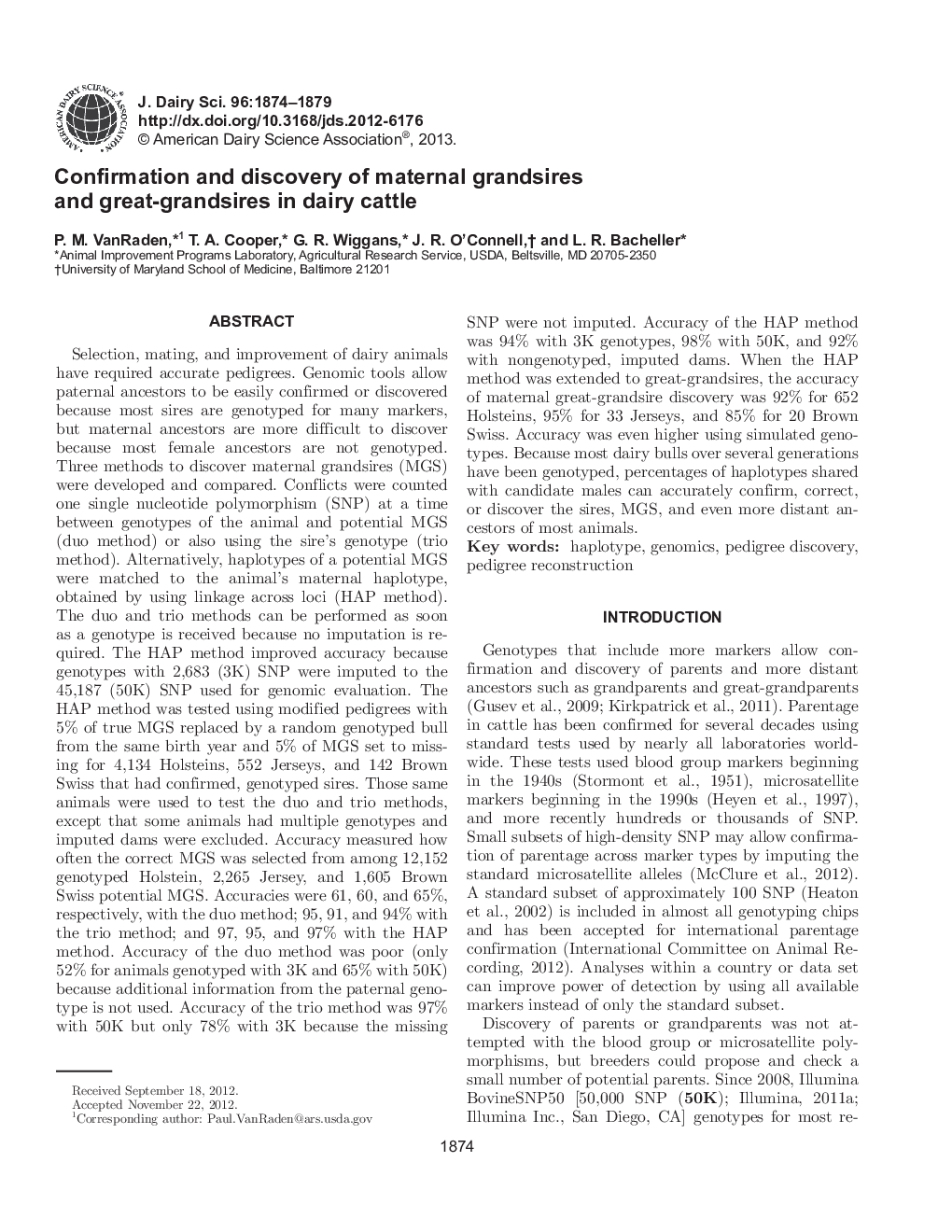| کد مقاله | کد نشریه | سال انتشار | مقاله انگلیسی | نسخه تمام متن |
|---|---|---|---|---|
| 10976243 | 1108039 | 2013 | 6 صفحه PDF | دانلود رایگان |
عنوان انگلیسی مقاله ISI
Confirmation and discovery of maternal grandsires and great-grandsires in dairy cattle
ترجمه فارسی عنوان
تأیید و کشف بزرگان مادر و بزرگان بزرگ گاوهای شیری
دانلود مقاله + سفارش ترجمه
دانلود مقاله ISI انگلیسی
رایگان برای ایرانیان
موضوعات مرتبط
علوم زیستی و بیوفناوری
علوم کشاورزی و بیولوژیک
علوم دامی و جانورشناسی
چکیده انگلیسی
Selection, mating, and improvement of dairy animals have required accurate pedigrees. Genomic tools allow paternal ancestors to be easily confirmed or discovered because most sires are genotyped for many markers, but maternal ancestors are more difficult to discover because most female ancestors are not genotyped. Three methods to discover maternal grandsires (MGS) were developed and compared. Conflicts were counted one single nucleotide polymorphism (SNP) at a time between genotypes of the animal and potential MGS (duo method) or also using the sire's genotype (trio method). Alternatively, haplotypes of a potential MGS were matched to the animal's maternal haplotype, obtained by using linkage across loci (HAP method). The duo and trio methods can be performed as soon as a genotype is received because no imputation is required. The HAP method improved accuracy because genotypes with 2,683 (3K) SNP were imputed to the 45,187 (50K) SNP used for genomic evaluation. The HAP method was tested using modified pedigrees with 5% of true MGS replaced by a random genotyped bull from the same birth year and 5% of MGS set to missing for 4,134 Holsteins, 552 Jerseys, and 142 Brown Swiss that had confirmed, genotyped sires. Those same animals were used to test the duo and trio methods, except that some animals had multiple genotypes and imputed dams were excluded. Accuracy measured how often the correct MGS was selected from among 12,152 genotyped Holstein, 2,265 Jersey, and 1,605 Brown Swiss potential MGS. Accuracies were 61, 60, and 65%, respectively, with the duo method; 95, 91, and 94% with the trio method; and 97, 95, and 97% with the HAP method. Accuracy of the duo method was poor (only 52% for animals genotyped with 3K and 65% with 50K) because additional information from the paternal genotype is not used. Accuracy of the trio method was 97% with 50K but only 78% with 3K because the missing SNP were not imputed. Accuracy of the HAP method was 94% with 3K genotypes, 98% with 50K, and 92% with nongenotyped, imputed dams. When the HAP method was extended to great-grandsires, the accuracy of maternal great-grandsire discovery was 92% for 652 Holsteins, 95% for 33 Jerseys, and 85% for 20 Brown Swiss. Accuracy was even higher using simulated genotypes. Because most dairy bulls over several generations have been genotyped, percentages of haplotypes shared with candidate males can accurately confirm, correct, or discover the sires, MGS, and even more distant ancestors of most animals.
ناشر
Database: Elsevier - ScienceDirect (ساینس دایرکت)
Journal: Journal of Dairy Science - Volume 96, Issue 3, March 2013, Pages 1874-1879
Journal: Journal of Dairy Science - Volume 96, Issue 3, March 2013, Pages 1874-1879
نویسندگان
P.M. VanRaden, T.A. Cooper, G.R. Wiggans, J.R. O'Connell, L.R. Bacheller,
